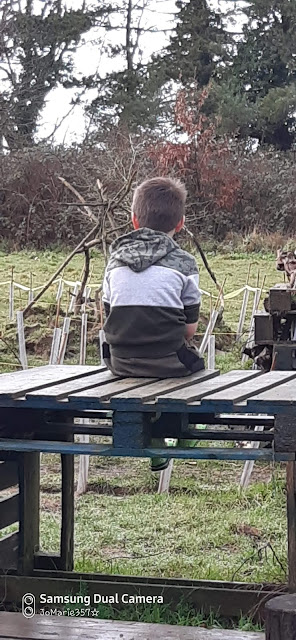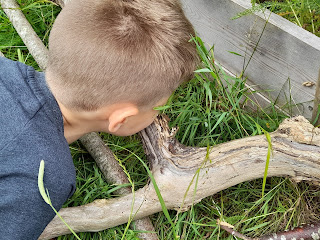Wellbeing & Resilience
Wellbeing is a difficult thing to gauge. Obtaining a sense of wellbeing requires different things for different children, and requires different things from each of us who work with them to help them achieve it.
Many adults are struggling to cope with Lockdown Restrictions, most of us are used to a very different existence, children are finding it difficult too, especially if the adults around them are not coping well. Research suggests the pandemic may affect children and vulnerable groups more than the general population (ie: Holmes et al 2020), so a Forest School active and experiential approach to learning is very important.
There is a lot to feel worried about at the moment. The disruption of 'normal' life, school routines, isolation from some friends and family, perhaps even the loss or serious illness of loved ones is a lot to adjust to.
Resilience for humans is defined as 'the capacity to recover quickly from difficulties', but when it comes to materials it is the 'ability of a substance or object to spring back into shape'.
For humans it seems to explain what happens after stress has gone, but for objects it sounds innate in it's structure during stress as well as afterwards. In a pandemic it may be that both are required from children!
Children are resilient, but the stresses of current life are ongoing and altering all the time. The structure of their childhood is ever-changing, so helping that resilience grow requires offering them ways to deal with change. Allowing emotions an outlet whether through physical exercise, a break from inside, a place to talk, or just a quiet space to just be.
Creating opportunities for them to increase their physical and mental wellbeing helps to temper whatever worries they have, being involved with good experiences during a difficult time offers some relief, and sets foundation blocks that resilience can be built upon.
As a Forest School delivering sessions outside, or a School taking learning outdoors, or even as an adult taking a child for a walk, you are helping to nurture a sense of wellbeing as well laying the groundwork for ongoing resilience, supporting a quicker 'spring back into shape' when life gradually returns to some kind of normal.
 |
| Hannah Bullen-Ryner Art |
Going outdoors improves health and fitness in everyone. Being in nature reduces stress, has been known to lessen fear and anger, and increases calm and even produce feelings of joy. It reduces blood pressure, heart rate, muscle tension and lowers the production of cortisol, the 'stress' hormone.
Of course space outside allows for physical wellbeing, room to be active, to develop good muscle tone and strong bone development. Daylight, even when there isn't a beaming sunny day, is better than lightbulbs and screens for concentration and headaches. A burst of fresh air clears the head and gives a sense of freedom. Body health and mental health are linked.
Outdoors the imagination has space too! To grow, to explore, to investigate. You can't separate intelligence and creativity. Critical thinking and problem solving comes from playing with ideas and developing solutions. Whether creating artistically or practically, outside provides far more possibilities than inside four walls, and boosts self esteem and confidence in the process.
'5,4,3,2,1' is an easy thing to do while outside. Focus on where you are for a while, ask the child or children to:
Look around and spot 5 things that they can see (an oak, a conker, a daffodil, a pond, a duck, a flying bird, an ant...etc)
Close their eyes, list 4 different things they can hear (blackbird, dog, aeroplane, heartbeat, ducks, people laughing...etc)
Find 3 textures or sensations you can feel (grass, bark, breeze, sun, rain...etc)
Smell 2 different scents (flowers, rain, grass, coffee from the cafe...etc)
Taste, 1 thing you can taste (toothpaste from this morning, lunch from just now, the rain or snow, a blackberry... etc)
It helps to connect with the outdoors so easily, and will change every time you do it! Join in yourself!
This is a 'Mindfulness' exercise, designed to help those participating to focus on being in the moment. It's a therapeutic technique that will help wellbeing to thrive.
The Mental Health Foundation has a PDF download about Thriving with Nature. It includes seasonal activities and is a great guide for anyone wanting to get outside more.
Covid restrictions make running Forest School sessions difficult, but if a School has their own Forest School provision on premises it can be much easier. Toileting facilities are within the building and are already risk assessed. Children can bring their own clothing so nothing needs to be shared. Tools can be wiped down between bubbles and disinfected over night. There are ways and means to make session covid safe and possible.
If this isn't possible Teachers can take a local walk and utilise the community space or school grounds, just a wander along the street or around the playground will provide opportunity. Current smaller bubble sizes may even make this more achievable. Parents and guardians, carers and childminders can aim for the same.
When Lockdown Restrictions ease, when children's lives shift again into full classes at school, and daily living begins to resemble what it was a year ago, everybody's wellbeing will have to adjust. Resilience will be needed for a change back into a life some children may not remember. Taking learning outside is an achievable way to boost children's wellbeing and mental health, which in turn is the best way to help children learn and settle once back inside. It is essential in the current 'Lost Learning' media panic (it's not lost, it's delayed!) and for whatever 'Learning Recovery' the Government will want implemented when schools resume a normal state.
Love Learning Outdoors allows you to download a pack for February that has suggestions for getting outside daily, which is great starting point at home or with a class.
Being outdoors is not only a big part of children's wellbeing, but a simple one to foster, with your own children or a class.
Just remember:











Comments
Post a Comment